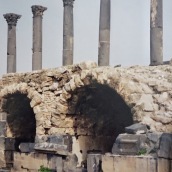
January 2001
Umm Qais was the second Friday excursion from the dig at Pella. Our route was along the Jordan Valley, armed with our passports because we were so close to Israel, but a seller of cos lettuce directed us up a very steep windy road, past a dam and olive trees instead.
Umm Qais, fortress and frontier town in ancient times, is now an extensive suite of ruins, with a view to the Gollan Heights and down through haze to the Sea of Galilee. We entered the ruins through an Ottoman village of black and white stone. The columns in the ruins included basalt, not the creamy pink of Jerash. I went through an arch which was in fact the vomitorium of a basalt-seated theatre which was being reconstructed. The top rows were a jumble of stone.
The cardo paving was quite intact, with clearly defined wheel ruts, and grass growing through the paving. It was edged with marble supporting columns. The arcade of shops with squared lintels was very similar to the souq in Damascus, although more regal in stone.
A large stone door, opening on two round stone hinges led into an underground mausoleum, with burial niches still containing sarcophagi.
We ate lunch – mezze, chicken and chips, and a can of beer – on a terrace with a spectacular view, the sound of goatbells the musical accompaniment, and then drove back along the Jordan Valley, past flimsy guard posts, and very close to the traffic travelling Israeli roads.
For a much more detailed look at Ajloun, Jerash and Umm Qais, read Cathy’s account of her adventures, and revel in her wonderful photos.













Jude often says she wishes your photos could be enlarged. This time I was about to say the same, but I clicked and up they popped. Thanks, it’s great to get a closer look. I’ve never seen basalt at any antiquity sites, was it local do you know?
I did a google search on vomitorium, quite revealing and amusing!
LikeLike
Your interest in rocks and geology is starting to make sense now. I am intrigued by the uniformity of these blocks of stone in the buildings.
LikeLike
I love these images, Meg, and have trotted over to Cathy’s for a different view….a place I would love to have seen in my fitter days!
LikeLike
Ignore last reply, it was for Jo!
LikeLike
In agreement with you on all points, Jo!
LikeLike
Thanks so much for taking me back to Umm Qais, Meg. As you know, I had a wonderful time there. I wonder if the place you ate was the same one where I ate? I find your description intriguing: “a vomitorium of a basalt-seated theatre.” I couldn’t help wondering if that was some kind of creative descriptive word made up by you, but then I looked it up to find it was “a passage situated below or behind a tier of seats in an amphitheatre or a stadium.” I’m always learning something new from you! 🙂
LikeLiked by 1 person
Meg is such a wordsmith, Cathy! I shall be over to yours next, as I’m sorry to say I don’t remember it. 😦 Meg, thank you for the Gallery style so I can look without my nose on the screen. The bit that amazes me is the wheel ruts. The impact of those chariots must have been something to behold! You’ve been to Damascus, haven’t you? That Israeli border…. it bends my mind just thinking about it. Such a waste of energy, all this hate.
LikeLiked by 1 person
In agreement with you on all points, Jo!
LikeLiked by 1 person
I don’t think you were following me yet when I went to Jordan in fall of 2011, Jo. So you would have probably missed my Jordan posts and others in the early days I was in Oman. I am also thankful to Meg for posting her photos in gallery style so I can see them in a larger slideshow. Seeing the Israeli border, and all the borders that come together at that point in Umm Qais, was very moving, especially considering the hatred and fighting that has been going on there for so many endless years.
LikeLike
The whole place is a nightmare, isn’t it? what a sorry mess we are sometimes!
LikeLiked by 1 person